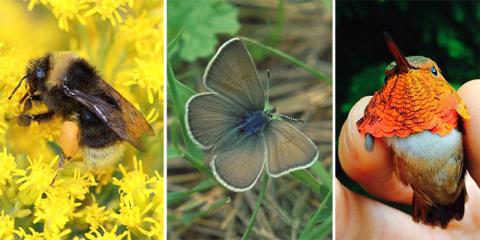Pollinators and forestry
January 24, 2018
Photo credits: (from left to right) Rich Hatfield, the Xerces Society; U.S. Army Corps of Engineers; Sarah Frey
Pollinators are very important to Oregon agriculture and gardening, because pollination is necessary for the production of many fruits and vegetables. But since Colony Collapse Disorder was first discovered in European honeybees in 2006, there has been a rising concern for the well-being of pollinators. As a result, scientists have sought to learn more about our native pollinators and the health of their populations.
Pollinators are any animal that moves pollen from one plant to another. In Oregon, pollinators include bees, beetles, butterflies, moths, hummingbirds, wasps and flies.
Scientists continue to gain a better understanding of just how important many native pollinators are to our state’s agriculture and garden crops. They’ve also learned that how the forests and wildlands around our agricultural land are managed can have an impact on pollinators.
For instance, it turns out managed forests are very important habitat for pollinators. That’s because pollinators thrive in disturbed sites such as recent burns, windfalls and timber harvests. A study being conducted by Jim Rivers of the Oregon State University College of Forestry’s Forest Animal Ecology Lab has shown that native bees are found in high numbers in the open areas where timber harvest was recently conducted. His research team has also found a higher abundance of bees in areas that burned in wildfires.
Open areas with full sunlight, including recent clearcuts, meadows, savannahs and pastures, can provide habitat for pollinators, especially if there are suitable plant forage and nesting opportunities. Besides open areas, pollinators need flowering plants because pollen and nectar are their main food sources. Planting these types of plants is a good way to help pollinators.
One Oregon forest products company, Portland-based Hampton Lumber, is experimenting with planting a custom pollinator-friendly seed mix in recent clearcuts on their timberland, to help boost native pollinator populations. Other forest landowners are watching this and considering doing the same.
To help forest landowners learn more about pollinators and ways they can help conserve native populations, OFRI recently published a new fact sheet called “Pollinators and Forestry.” You can download a copy here. The fact sheet features a list of plant species that could be included in pollinator-friendly seed mixes. It also lists the understory plants that benefit from and are important for pollinators. These are good species to keep across the landscape to support healthy pollinator populations.
With the research showing that pollinators benefit from managed forests, conscious management decisions such as planting pollinator-friendly seed mixes after a timber harvest could enhance those benefits. By providing a mosaic of different age classes, including recently harvested areas with forage and nesting opportunities near farmland, forestry could help make a difference for declining pollinator populations.
For the forest,
Mike Cloughesy
Director of Forestry
&
Fran Cafferata Coe
Certified Wildlife Biologist ®
